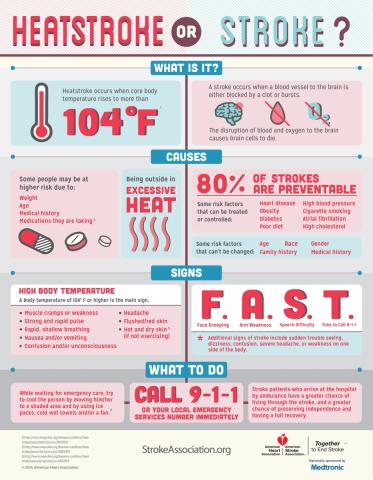Is It a Stroke, or Heat Stroke?
Seniors are at higher risk of heat-related illness, and should receive prompt medical attention if they display the signs of heatstroke. But it’s important, says the American Heart Association/American Stroke Association, not to confuse heatstroke with stroke, because although both should be treated immediately, the treatments are quite different.
“While heatstroke contains the word ‘stroke’ and both are potentially life-threatening medical emergencies, stroke and heatstroke are not the same condition,” said Rani Whitfield, M.D., family practitioner and American Stroke Association spokesperson.
Stroke
A stroke occurs when a blood vessel to the brain is either blocked by a clot or bursts. The disruption of blood and oxygen to the brain causes brain cells to die.
If someone is exhibiting stroke warning signs, bystanders should call 9-1-1 immediately and let the operator know it may be a stroke. Symptoms of stroke include:
- Facial drooping
- Arm weakness
- Speech difficulty
- Additional signs such as sudden trouble seeing, dizziness, confusion, severe headache, or weakness on one side of the body.
If any of the above signs are present, you should call 9-1-1 immediately. The American Stroke Association teaches the acronym F.A.S.T. for stroke: Face drooping, Arm weakness, Speech difficulty, Time to call 9-1-1.
“Stroke patients who arrive at the hospital by ambulance not only have a greater chance of living through the stroke, but also have a greater chance of preserving independence and having a full recovery,” Dr. Whitfield said.
Need another reminder? Dr. Whitfield collaborated on a hip-hop video for the American Heart Association. Check it out on YouTube!
Heatstroke
Heatstroke, sometimes called sunstroke, occurs when core body temperature rises to more than 104° F and organs can’t function properly. “Heatstroke is brought on by external environmental factors, usually being outside or exercising outside on very hot days,” Dr. Whitfield said. “Some people may be more susceptible to heatstroke due to age, weight, medical history, or medications they are taking. It’s important to know your individual risk for heatstroke just as you do for stroke.”
Take steps to cool down and get medical attention immediately if someone is experiencing any of the following signs of heatstroke:
- Body temperature of 104° F or greater
- Lack of sweating (skin will feel hot and dry, unless heatstroke is cause by exercise)
- Nausea, vomiting or both
- Flushed/red skin
- Rapid, shallow breathing
- Headache
- Confusion and/or unconsciousness
- Muscle cramps or weakness
- Strong and rapid pulse
“Heatstroke is life-threatening. If you suspect someone is suffering from heatstroke, you should immediately try to cool them down and call 9-1-1,” Dr. Whitfield said. “Take them out of the sun, have them drink a cool, nonalcoholic beverage without caffeine, preferably water, and fan them with cool air.”
Visit the American Heart Association/American Stroke Association website to view an infographic to help consumers understand the difference between stroke and heatstroke.
